How Do I Climb Kilimanjaro?
With a high success rate, gorgeous views and guaranteed adventure, summiting Kilimanjaro remains one of the most popular things to do in East Africa. However, the journey requires exposure to the elements and significant altitude so it pays to do some research to ensure your Kilimanjaro climb goes as successfully as possible. This Kilimanjaro FAQ aims to answer the simple question: ‘How do I climb Kilimanjaro?’
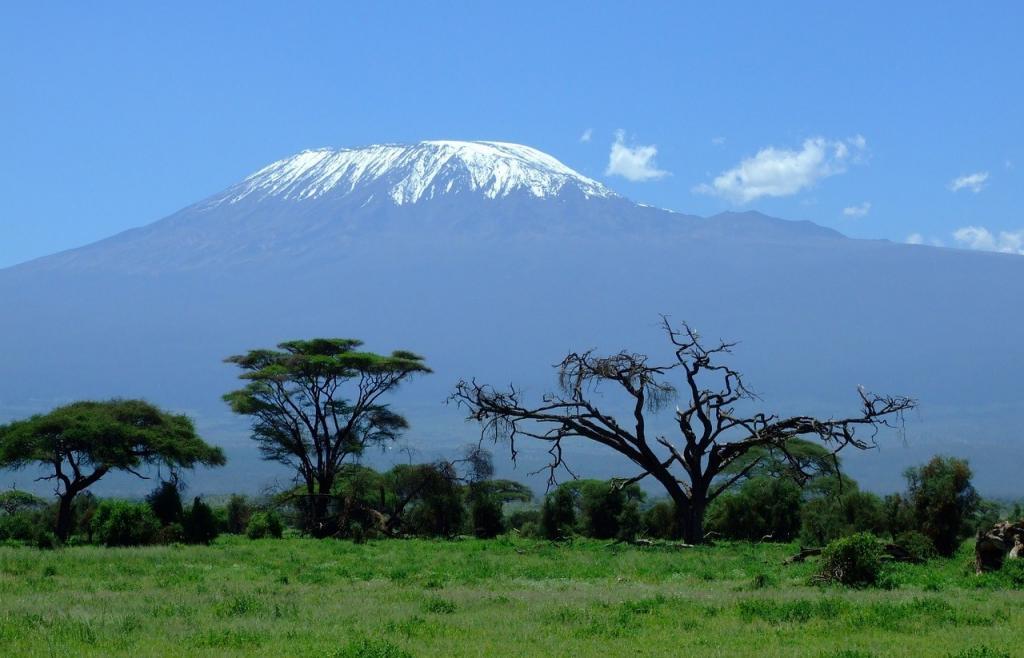
Where is Kilimanjaro?
Kilimanjaro is the highest mountain in Africa, with its summit at 5,895 metres (19,342 feet). It is in the country of Tanzania, on the eastern side of Africa, south of Kenya and north of Mozambique. The official language of Tanzania is Swahili but your guides are sure to know English (and you should pick up a Swahili phrase or two during the climb).
What dates should I plan to climb Kilimanjaro?
The best months to climb Kilimanjaro are in two separate seasons: January-March and June-October. These windows tend to be the drier months with less rain and snowfall, which make trekking much easier. The January-March climbing season tends to be slightly wetter, while the June-October season tends to be more crowded as more Europeans and Americans take holidays. The European summer (June through August) is peak season.
Temperature, cloudiness, crowds and full moon dates are all relevant factors when considering when to ascend to the ‘Roof of Africa’. Here’s more detail to help determine which month will work best for you.
What route should I choose to climb Kilimanjaro?
There are a number of routes used to summit Kili, all named for the area where the climb begins. The amount of time it takes to summit the mountain depends on what route you have chosen. While all climbs leave a trekker at risk of altitude sickness, there is often an increased success rate for climbs that allow for an extra acclimatisation day. While this extends your ascent and so increases costs, it also allows your body to become more adjusted to the high altitudes.
After the summit day, most routes allow for the option to either descend completely to the bottom of the mountain via the Mweka route on the same day you summit, or to stop at Mweka camp for one more night and resume the final descent the following morning. Either way, the descent is significantly faster and shorter than the hike up. Below is a list of the five most popular routes.
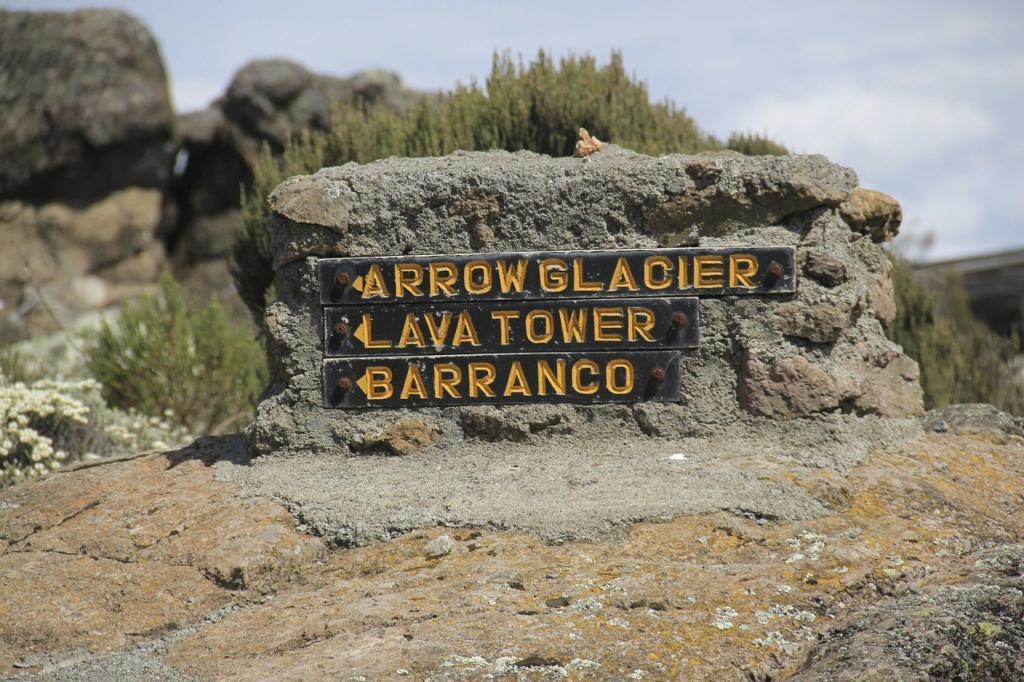
Marangu:
- Difficulty: Medium
- Duration: Typically completed in five days with an optional acclimatisation day
- Starting Altitude: 1,860 meters (6,100 feet)
Pros: This is the shortest and generally cheapest route. There is also an option to sleep in “bunk houses” on several camps along the Marangu route, which can be a great alternative to chilly nights in a tent.
Cons: Marangu has the most traffic and the quick ascent leaves your body little time to get acclimatised to altitude. Furthermore, the ascent is the same as the descent, so there is little variety and no chance for new scenery.
Summit Day: On the Marangu route, you camp at Barafu – 4,572 meters (15,000 feet) – the night before ascent. After a midnight wakeup call, you hike seven or eight hours to the summit. Marangu has the highest failure rate for summiting, but this could be due to its popularity. Especially during the European summer peak, tourists complain of long queues during the ascent up, and long lines for the toilet.
Machame
- Difficulty: Medium
- Duration: Typically completed in seven days
- Starting Altitude: 1,743 meters (5,718 feet)
Pros: Machame is known for very scenic views through the rainforest as you begin your hike towards the south side of the mountain. The longer ascent allows your body to become acclimatised to altitude
Cons: High traffic and often crowded
Summit Day: Similarly to Marangu, summiting Kilimanjaro from the Machame route means camping at 4,572 meters (15,000 feet) at Barafu the night before ascent. There’s a brutal midnight wakeup call, a seven- or eight-hour hike to the summit and a lengthy descent down the mountain (with the optional stop at Mweka camp for an extra night). Barafu means “ice” in Swahili. When camping, you will understand how it got its name.
Shira
- Difficulty: High
- Duration: Typically completed in seven days
- Starting altitude: 3,353 meters (11,000 feet)
Pros: Shira has significant less traffic as it is a less popular route.
Cons: This route starts at a very high altitude which makes it difficult for the body to acclimatise to the altitude.
Summit day: Like the Marangu and Machame routes, the Shira route also ascends via Barafu, requiring a 1,219-meter (4,000-foot) ascent in one night.
Lemosho Route
- Difficulty: High
- Duration: Typically completed in nine days
- Starting altitude:2,360 meters (7,743 feet)
Pros: Lemosho is known as the most scenic route with least amount of traffic. The longer trip means more time to acclimatise to altitude.
Cons: The long hike often makes this the most expensive option.
Summit Day: The last night before the ascent is spent at a high altitude of 5,730 meters (18,800 feet) at Crater Camp, instead of Barafu camp. This makes summit day significantly easier.
Umbwe
- Difficulty: Very difficult
- Duration: Recommended to be completed in six to seven days
- Starting Altitude: 1,600 meters (5,249 feet)
Pros: This route is a great challenge for experienced climbers and boasts beautiful, scenic views.
Cons: The Umbwe route begins high and steep, and is a very quick ascent given the terrain. Often times, tree branches are needed to help hoist yourself up, while sheer rock faces need careful navigation. This is not for people with a fear of heights.
Summit Day: This route uses the traditional Barafu camp summit. Those who choose this route should have previous experience at high altitude.
No matter what route you choose to take, you can expect to see a wide range of environments that change steadily as the altitude increases: from lush, green rainforests to rocky switchbacks. There will also be portions of the hike that require you to use both your hands and your feet to ascend (notably, the Barranco Wall, which is summited on day 4 of most routes).
The most critical questions to ask when choosing a route are: “What are my physical capabilities?” and “What are my time and price constraints?”. If you honestly assess these questions, you will be sure to pick a Kilimanjaro route that is right for you.
Can I trek Kilimanjaro solo?
Even the most experienced mountaineers cannot trek Kilimanjaro alone. Tanzanian law requires a guide.
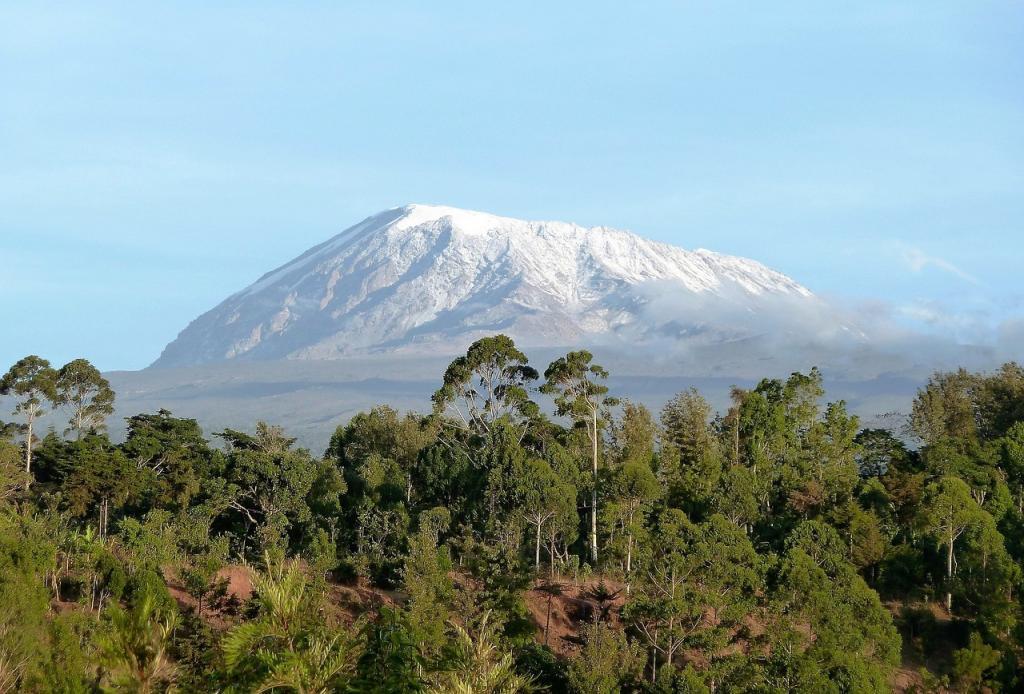
How much does climbing Kilimanjaro cost?
The price of climbing Kilimanjaro ranges from USD $1,400 to $6,000, which includes fees, food, guides and porters, but not tips for guides or travel insurance, an essential when approaching a trip at this altitude. A good ballpark is approximately $4,000 per person (you can check some options on Get Your Guide). While there are extra amenities one can pay for on a trek (such as a private tour, a portable shower or thicker mattresses), even the most high-end Kilimanjaro treks involve a degree of roughing it.
Furthermore, it is important not to choose a Kilimanjaro trekking company based solely on price. Be sure to inquire about their policy regarding porters. Historically, these workers have been underpaid, underfed and uninsured, and going with a company that respects the work the porters do and pays them fairly is essential. The Kilimanjaro Porters Assistance Project can help choose an ethical tour company that treats all employees fairly.
Here’s an approximate breakdown of average climbing expenses across all routes. Keep in mind that there are many variables: the route, duration and amenities will all affect prices.
- Park fees (approx. $200/person/day): $1,500
- Wages for guides/porters/cooks: $1,000
- Supplies: $300
- Taxes: $200
- Accommodation before and after the climb: $200
- Commission for tour operator (approx. 25%) $800
TOTAL: $4000
What travel insurance do I need to climb Kilimanjaro?
Travel insurance is essential for climbing Kili, where around 30 hikers die every year and many more are injured or fall ill with significant altitude sickness. For many nationalities World Nomads is the most affordable option. It offers trekking cover to as high as 6,000 metres (19,685 feet), whereas many adventure insurers cap out at 5,000 metres (16,404 feet) or lower. As always, please read the Ts & Cs.
What will the climate be like?
During the ascent up Kilimanjaro, most hikers will pass five different climate zones:
- Bushland: warm temperatures and low grass
- Rainforest: wet and lush with lots of plants and wildlife
- Heath: colder but often abundant in wildflowers
- Alpine desert: low rainfall, reduced plant life and lower temperatures
- Arctic summit: rocky and icy
Logically, the higher the elevation, the colder the temperatures become. In a single climb, temperatures might range from 27°C (80°F) at the base to -29°C (-20°F) at the summit.
What gear do I need to climb Kilimanjaro?
Everything you take with you must be carried up on the head or the back of a porter, so packing conservatively is a must. Rolling clothes instead of folding will help save room within your pack. Here’s a suggested packing list for a 6-day climb.
Clothing
- Underwear (5 pairs)
- T-shirts (4)
- Long-sleeve (moisture wicking) base layer (1-2 pairs)
- Fleece jacket (1)
- Trekking pants (1 pair)
- Snow/winter jacket (1)
- Snow pants (1 pair)
- Rain jacket (2)
Footwear
- Hiking boots (broken in)
- Trekking sandals (for showers or for evenings you want to take your hiking boots off)
- Wool socks (5 pairs)
Other Accessories
- Inner layer/thermal gloves
- Heavy waterproof mittens
- Trekking poles
- Gaiters for boots (this keeps rocks, sand, and snow out of your hiking boots)
- Headlamp (with extra batteries)
- Sunglasses
- Beanie/warm hat
- Baseball hat/Sunhat
- Day pack
- 2-litre (or 64-ounce) water bottles (2)
Other Must-Haves
- Buffs are great for people with long hair – and can help keep your neck warm too
- Baby wipes can make a great substitute for a shower
- A good book (there is not a lot else to do in the evenings)
- A deck of cards
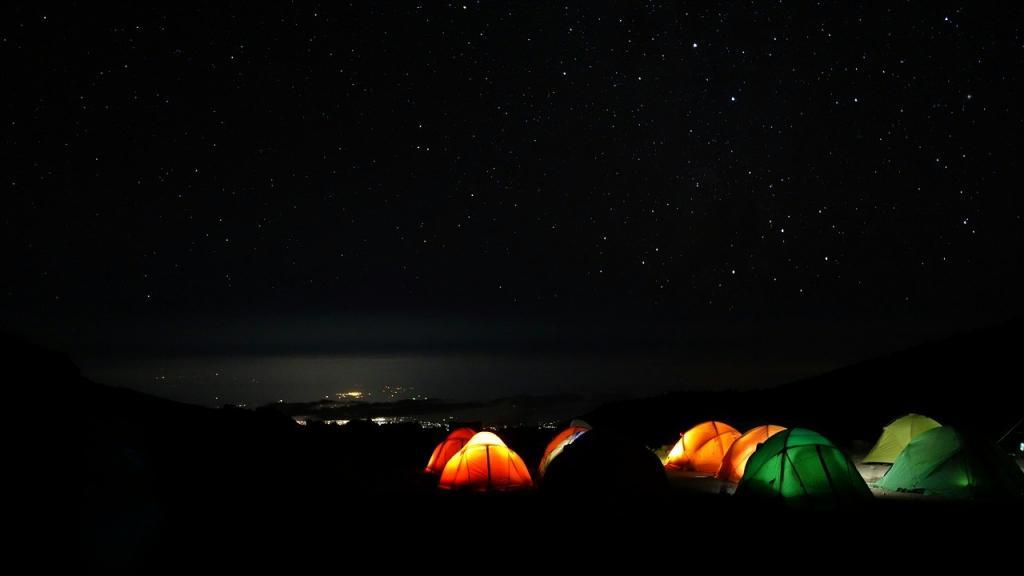
Where will I sleep on Kilimanjaro?
Most operators put one or two people in a tent on the ascent. Couples are generally paired together, while solos are can pay slightly more to be put in separate, single tents (which is often worth the price for a better night’s sleep). Guides generally provide tents and warm sleeping bags and set them up for you. The Marangu route has the option of sleeping in bunks in a hut, which can be a warmer option, depending on how you cope with snoring.
How many guides and porters will there be?
The average ratio is two guides to four climbers. The role of the guides is to inform you of the day’s activities, lead you through the hike, and answer any questions you may have. The guide will also ensure you are getting enough to eat and drink, be your point of contact if you are feeling unwell and act as motivation during the toughest parts of the climb.
Each climber will also require between two and six porters, depending on the amenities your trekking operator provides. It’s easy to forget that drinking water, bathing water, food, stoves, sleeping bags and tents don’t wait at your camp for you: someone has to be there to carry them up.
What is the food like on the Kilimanjaro summit climb?
Don’t let the terrain fool you. Kilimanjaro cooks are well versed in providing food in interesting conditions and pride themselves on hearty meals. Most treks include a variety of options at each meal, as it can be hard to keep an appetite at high altitude.
Expect a stiff porridge, bread, sausage and eggs in the morning, as well as plenty of fruit, jam and peanut butter. There is often soup with lunch (to warm you up) along with a hearty rice and meat dish, fresh fruit, fresh vegetables and condiments to spice your food. For dinner, the menu typically begins with another soup followed by stew, pasta with meat sauce and fresh salad. Guides also keep snacks on hand, and encourage you to pack granola, fresh fruit, or a sandwich in your day pack to keep you energized throughout the day.
How do I stay clean when climbing Kilimanjaro?
“Luxury” Kilimanjaro experiences include a makeshift warm shower that the guides pack up and set up in your campsite, although more often than not you will feel too chilly to want to strip down. The vast majority of climbs just provide a hot bowl of water at your tent before you go to sleep. If you have long hair, keeping it in braids increases cleanliness, while baby wipes are a life-saver for everyone.
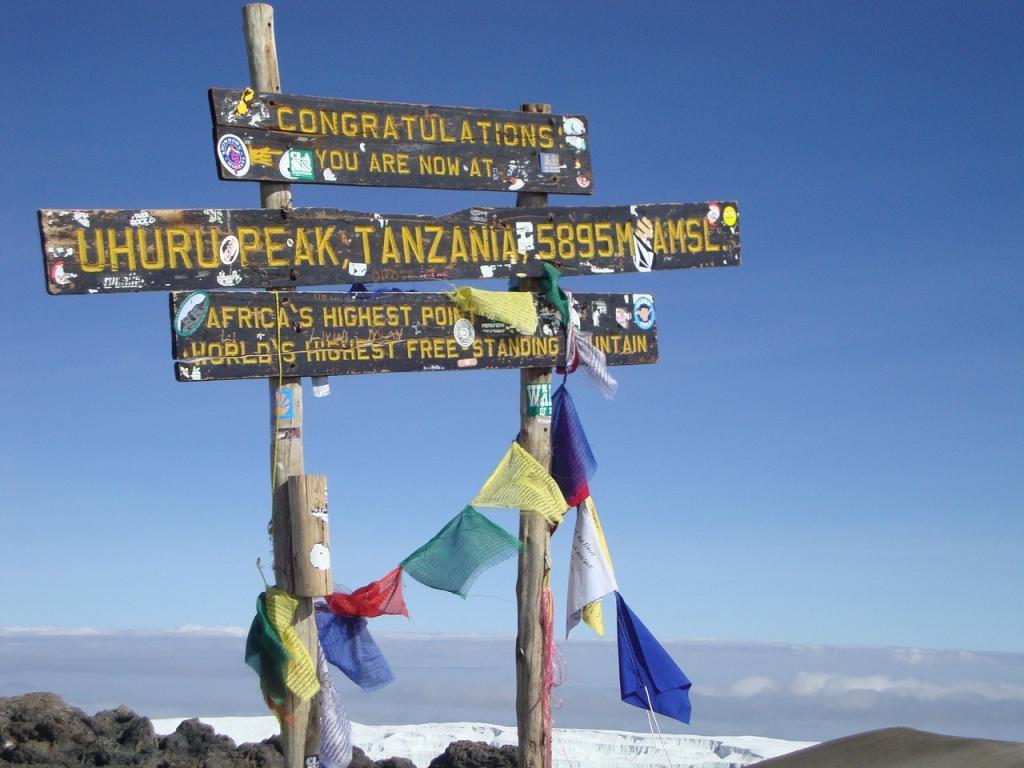
What should I do if I experience altitude sickness?
Altitude sickness is a very serious illness and should not be taken lightly. While most people will experience some response to altitude on the mountain, it is important to look out for more extreme symptoms that mean you need to descend. (Altitude.org has great altitude sickness advice.)
The more manageable signs of altitude sickness include hangover-like symptoms: nausea, light-headedness, vomiting and shortness of breath. More extreme symptoms, such as difficulty walking or a decline in mental capacity could mean you are suffering from HACE (High Altitude Cerebral Edema), which can be fatal. HAPE (High Altitude Pulmonary Edema) is another potential risk at high altitudes and involves a cough, fever, and occasionally, blood and mucus from the lungs: this can also be fatal.
When signs of HAPE or HACE present themselves, it is time to head down the mountain. Doctors recommend gradual descent as the mandatory remedy for those experiencing HAPE or HACE symptoms, although some will also require hospital treatment: be sure you have travel insurance that covers you for trekking at altitude.
Guides will remind you, but it can’t be said often enough: drink water, even when you are not thirsty. Significantly increasing your water intake a week before the climb can help decrease the affects you feel from altitude. Prescription Acetazolamide (Diamox) can also help decrease altitude sickness: talk to your doctor about potential side effects and the risks of getting altitude sickness while using Diamox before you decide.
How physically fit do I need to be in order to climb Kilimanjaro?
The Kilimanjaro climb is more a test of your body’s resilience than actual fitness level.
Cold, blisters and altitude sickness are what tend to keep people from summiting the mountain. Prepare for Kilimanjaro in the same way you would prepare for a race: break in your hiking boots and practice being on your feet for several hours per day.
If possible, understands how your body reacts to high altitudes. A marathon runner may be very physically fit yet operate poorly at altitude. In the same way, someone who is not accustomed to strenuous physical activity may do very well at high altitude. Be aware that the same individual may react very differently to altitude on different occasions.
Most Kilimanjaro tours instruct their guides to check the blood oxygen level of trekkers with a pulse oximeter, which clips painlessly on the tip of your finger. While this is a reasonable predictor of potential altitude problems, it’s not 100%. Listen to your body and tell your guides what it’s saying.
Is climbing Kilimanjaro safe?
People do die climbing Kilimanjaro but the trek is, considering the elevation, relatively safe. The guides are trained and know the mountain well. Some have climbed the mountain more than 500 times. If you pick the right outfitter, are honest with your guide when you are feeling unwell and follow their instructions, there should be no safety concerns.
As mentioned before, altitude sickness is your greatest threat on the mountain. Understanding how your body reacts to altitude – what is a safe but uncomfortable feeling, and what is an unsafe level of discomfort – is crucial for your Kilimanjaro ascent. Blisters and sunburns are far more common than lethal falls or hypothermia. Coming prepared with adequate gear for hiking and sleeping and choosing a well-resourced tour will greatly reduce these risks.
Will I summit Kilimanjaro?
Whether or not you reach the summit of Kilimanjaro, known as Uhuru (Freedom) Peak, depends on how well your body reacts to altitude and how far you are willing to push yourself. Most people don’t spend much time at the summit due to the high altitude: just long enough to snap a few pictures.
Seven-day climbs see an 80% summit rate; six-day climbs see a 65% summit rate; for five-day climbs, the rates are lower. Even if you do not summit… hakuna matata! The joy is in the journey of hiking to one of the most beautiful places on earth.

Thanks so much for the details Theodora!
Have I ever climbed Mount Kilimanjaro? Nope!
Do I want to? Oh yes!
But I warn you now, very high mountains and myself aren’t best buddies. At all! Here’s a previous attempt. Eek!: https://thebritishberliner.wordpress.com/2014/12/08/the-beginners-guide-to-going-up-a-volcano-because-going-up-a-volcano-isnt-for-everyone/
Hi Victoria, this was actually a guest post by the lovely Ella Kerr! But thank you, anyway…
amazing post, Theo. I don’t have courage of climbing anything higher than an average stair, I’m afraid of high heights, plus, I’m terrified of death, so, I don’t dare doing it. lol! my knees and hips as well as my back are already messed up. Still, I absolutely LOVE jogging and doing Stand Up Paddle – sadly, here in Belém we only have a dirty, muddy river, with strong currents -, so, no suitable for it either ? I’m curious about visiting REAL Africa someday, no just Tenerife, which is mostly Spanish than African, with a somewhat Thai hint.
With love,
Sooi_dog